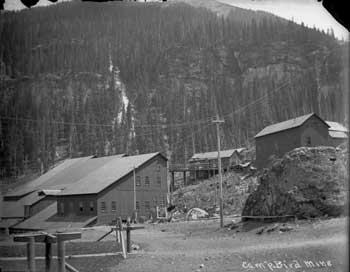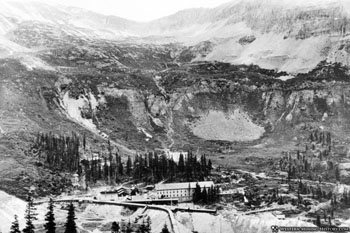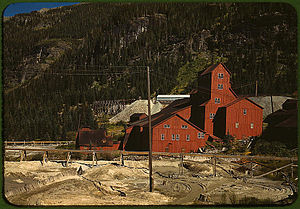Ouray County COGenWeb
COGenWeb a proud partner of USGenWeb
Camp Bird Mine
 The Camp Bird Mine is a famous and highly productive old gold mine located between Ouray and Telluride, Colorado. The mine is within the Sneffels-Red Mountain-Telluride mining district in the San Juan Mountains.
The Camp Bird Mine is a famous and highly productive old gold mine located between Ouray and Telluride, Colorado. The mine is within the Sneffels-Red Mountain-Telluride mining district in the San Juan Mountains.
The Camp Bird mine was discovered in 1896 by Thomas Walsh, who would go on to be one of Colorado's most successful mining men. Walsh was prospecting the Imogene Basin above Ouray, Colorado during a time when most miners had given up on the area. The basin was historically a silver mining area, and the silver panic of 1893 had put the area into an economic depression. Walsh thought there might be undiscovered gold in the Imogene Basin, and he began buying up old claims. His hunch was correct, and he discovered rich gold ore on one of the claims. Walsh operated in secrecy through the rest of 1896, keeping his discovery private while buying up many more claims in the basin.
 Camp Bird is named after the "Camp Birds", probably Gray Jays, that ate many a miner's lunch. Western Colorado native David Lavender related his experiences working at the Camp Bird Mine in the 1930s in his classic memoir One Man's West.
Camp Bird is named after the "Camp Birds", probably Gray Jays, that ate many a miner's lunch. Western Colorado native David Lavender related his experiences working at the Camp Bird Mine in the 1930s in his classic memoir One Man's West.
C.W. McCall sang "Way out in Colorado, in the Camp Bird Mine, down deep in the darkness, on level nine..." The song moved the mine's founding to 1892 to make the rhyme work and added a ghost.
The Camp Bird Mine filed for a permit to resume mining in late 2007, but remains inactive as of August 2008. In 2012, the mine received permits to rehabilitate existing mine workings.
 In August 2017, the Environmental Protection Agency (EPA) and the State of Colorado signed an Administrative Order on Consent with Caldera Mineral Resources, which purchased the property out of bankruptcy. The Order specifies on-site erosion control "to prevent the downstream migration of contaminated soil", with work to be accomplished in two phases. Phase 1, the EPA's Time-Critical Removal Action, was started in August 2017, and was scheduled for completion in October 2018.
In August 2017, the Environmental Protection Agency (EPA) and the State of Colorado signed an Administrative Order on Consent with Caldera Mineral Resources, which purchased the property out of bankruptcy. The Order specifies on-site erosion control "to prevent the downstream migration of contaminated soil", with work to be accomplished in two phases. Phase 1, the EPA's Time-Critical Removal Action, was started in August 2017, and was scheduled for completion in October 2018.
Click on images for a larger image.
This page was last updated